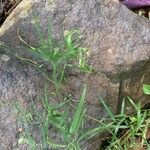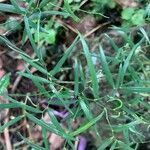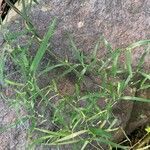An evergreen climbing plant. It grows to 1-8 m high. It keeps growing from year to year. The stem is smooth and wiry and has many branches. Many branches can often be leafless. The leaves are oval or long shaped with fine veins. They are 5-8 cm long by 1-2 cm wide and have short leaf stalks. The flowers are star-like and creamy white, green or purplish. They have 3 petal-like sepals and 3 petals. These flowers occur in heads which hang over and are at the ends of branches. The heads are 10 cm long. The flowers have a sweet smell. The fruit are bluish-black round berries. They are 0.8 cm across.
Climber to 10 m; stems to 10 mm diam. Leaves ovate to linear, acute; lamina 2–13 cm long, 2–35 mm wide; petiole 0.5–1.5 mm long. Inflorescence branched; pedicels 5–10 mm long. Flowers 10–22 mm diam., white to pale mauve, apical portion green. Sepals and petals 5–11 mm long. Stamens 4–10 mm long; filaments filiform; anthers 3–5 mm long. Ovary ± globose, 2–3 mm long, glabrous; style 5–7 mm long. Berry 7–20 mm diam., black. Seeds angular, ± globose; testa hard.



